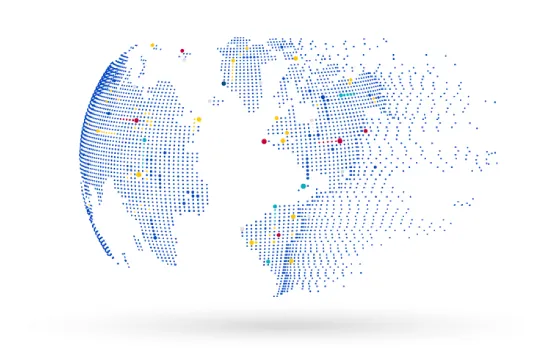What is Global Threat Intelligence?
Global Threat Intelligence is the process of collecting, analyzing, and sharing data about potential or active cyber threats across the globe. It goes beyond traditional security practices by offering a broader, real-time view of the evolving threat landscape. Rather than relying solely on internal logs or local incidents, global threat intelligence aggregates data from a wide array of sources—government agencies, threat research organizations, cybersecurity vendors, open-source feeds, dark web forums, and honeypots—to create a centralized and enriched understanding of attacker behaviors and intentions.
The primary goal of GTI is to help organizations make informed decisions about their cybersecurity strategies. It transforms vast amounts of raw data into actionable insights that security teams can use to identify vulnerabilities, prioritize alerts, detect anomalies, and respond to incidents more effectively. By providing context—such as who the attacker is, what their motivation might be, and which industries or regions they’re targeting—global threat intelligence allows businesses to anticipate attacks before they happen.
There are several types of threat intelligence within the global context. Strategic intelligence provides high-level insights tailored for executives and decision-makers, often highlighting long-term trends or geopolitical risks. Tactical intelligence focuses on the tools, techniques, and procedures (TTPs) used by threat actors, which helps security teams update their defenses. Operational intelligence gives information on specific attacks in progress or campaigns being carried out by cybercriminal groups. Technical intelligence, on the other hand, includes indicators of compromise (IOCs) such as IP addresses, file hashes, and malicious domains that can be used to block threats in real time.
GTI is particularly valuable in a world where cyber threats don’t respect borders. A malware campaign that originates in one country can quickly spread to others. Likewise, ransomware groups may shift their focus across industries and regions based on opportunity and perceived weaknesses. Without access to global insight, organizations risk being blindsided by new or previously unknown attack vectors.
The adoption of threat intelligence platforms (TIPs) has made it easier for companies to aggregate, analyze, and act on this intelligence. These platforms integrate with existing security tools like SIEMs, firewalls, and endpoint detection systems, enabling real-time response to new threats. Ultimately, global threat intelligence isn’t just about understanding the cyber threat landscape—it’s about staying ahead of it. For organizations serious about cybersecurity, it's a foundational element of a modern, proactive defense strategy.
Why Global Threat Intelligence Matters
Global Threat Intelligence matters because it provides organizations with the context and foresight needed to defend against an increasingly complex and fast-evolving cyber threat landscape. In today’s hyperconnected world, cyberattacks can originate from anywhere and target anyone—regardless of company size, industry, or location. Traditional security approaches that rely solely on perimeter defenses or internal data are no longer sufficient. Threat actors are using more sophisticated techniques, often blending automation, artificial intelligence, and global networks of compromised devices to evade detection. Without access to timely and relevant intelligence, security teams are left reacting to incidents rather than preventing them.
By leveraging GTI, organizations gain real-time visibility into emerging threats, attack trends, and adversary behaviors. This insight allows them to anticipate and neutralize threats before they reach their environment. It also enables faster and more accurate incident response by enriching alerts with threat context—such as whether a detected IP address has been linked to ransomware groups or if a particular file hash has been seen in known malware campaigns.
Another reason global threat intelligence is so critical is its role in prioritizing risk. Not all threats are created equal. Intelligence-driven security helps organizations understand which threats are most relevant to their industry, geography, or technology stack. This means teams can focus their limited resources on high-impact vulnerabilities and avoid wasting time chasing low-risk alerts. This is especially important for small and mid-sized businesses that may lack large security operations teams.
Additionally, global threat intelligence plays a key role in security automation. When integrated with security tools like SIEMs, endpoint protection platforms, and intrusion detection systems, intelligence feeds can trigger automatic blocking of malicious domains, alerting on suspicious behavior, or quarantining compromised endpoints—significantly reducing the time between threat detection and response.
Threat intelligence also strengthens collaboration. As cyber threats become more organized and coordinated, the cybersecurity community must work together. Sharing intelligence across industries, sectors, and borders allows defenders to learn from each other’s experiences and stay ahead of attackers. Government agencies, information sharing and analysis centers (ISACs),and private threat intel providers all contribute to this collective defense model.
Ultimately, global threat intelligence matters because it transforms a reactive security posture into a proactive one. It empowers organizations to make smarter decisions, respond faster, and reduce risk in a constantly changing digital world. For any business aiming to improve its cybersecurity maturity, investing in threat intelligence is no longer optional—it’s essential.
Types of Global Threat Intelligence (Strategic, Tactical, Operational, Technical)
Global Threat Intelligence can be broken down into four main types: strategic, tactical, operational, and technical. Each type serves a different purpose, caters to a specific audience, and contributes to a comprehensive understanding of the global cyber threat landscape. Together, they form the foundation of an effective, layered threat intelligence program that allows organizations to anticipate attacks, prioritize risks, and respond more effectively.
Strategic threat intelligence is high-level and geared toward executive decision-makers, such as CISOs, CIOs, and board members. It focuses on long-term trends, geopolitical risks, industry-specific threats, and the overall threat landscape. Strategic intelligence helps leadership teams understand the potential impact of cyber threats on business objectives and regulatory compliance. It provides context for making informed decisions about cybersecurity investments, policy changes, and risk management strategies. Rather than focusing on technical details, strategic intelligence connects the dots between global events and organizational security.
Tactical threat intelligence is aimed at security teams and focuses on the tactics, techniques, and procedures (TTPs) used by threat actors. It helps defenders understand how adversaries operate—what tools they use, how they exploit vulnerabilities, and what their typical behavior patterns look like. This information is crucial for strengthening defenses such as firewalls, endpoint protection, and intrusion detection systems. By mapping threat actor behavior to frameworks like MITRE ATT&CK, organizations can identify gaps in their defenses and improve their detection and response capabilities.
Operational threat intelligence provides timely information about specific threat campaigns, active attacks, or threat actors targeting particular regions or industries. This type of intelligence is especially valuable for incident response teams who need real-time insights to contain and mitigate threats. Operational intel often includes reports on current malware campaigns, phishing tactics, ransomware operations, or newly discovered exploits. It helps organizations stay informed about what’s happening right now and prepares them to act quickly in response to evolving threats.
Technical threat intelligence is the most granular and machine-readable form. It includes specific indicators of compromise (IOCs) such as malicious IP addresses, domain names, file hashes, URLs, and email addresses associated with cyber threats. This type of intelligence feeds directly into security tools and platforms, enabling automation and real-time blocking of known threats. While it’s the most reactive type of intelligence, it plays a crucial role in identifying and stopping known attacks at the earliest stage.
Each type of threat intelligence provides unique value, and when combined, they offer a powerful framework for defending against cyber threats. Organizations that leverage all four can make better decisions, reduce response times, and create a more resilient cybersecurity posture.
Global Threat Intelligence vs Traditional Threat Detection
Global Threat Intelligence and traditional threat detection are both important components of cybersecurity, but they serve different purposes and operate in fundamentally different ways. Understanding the distinction between the two is critical for building a modern and proactive security strategy that can keep up with the evolving threat landscape.
Traditional threat detection relies on predefined rules, signatures, and known patterns to identify malicious activity within an organization’s network or systems. These tools are often reactive in nature, meaning they can only detect threats that have already been identified and documented. Antivirus software, firewalls, and intrusion detection systems (IDS) typically fall into this category. While effective at stopping known threats, traditional detection methods struggle to keep up with novel attacks, zero-day vulnerabilities, or sophisticated adversaries that use evasion techniques to bypass legacy defenses.
Global Threat Intelligence, on the other hand, is proactive and data-driven. It involves gathering information from a wide range of global sources—including threat feeds, dark web forums, open-source intelligence (OSINT),government agencies, and cybersecurity vendors—to create a broader understanding of potential threats before they directly impact an organization. This intelligence includes data on attacker behavior, tactics and tools, campaigns in progress, and emerging vulnerabilities. It allows organizations to anticipate threats, understand their potential impact, and adjust their defenses accordingly.
One of the biggest advantages of global threat intelligence is context. Traditional detection systems may flag a suspicious file or IP address, but without threat intelligence, security teams are left guessing about its relevance or urgency. Global threat intelligence enriches these alerts with additional data, such as whether the indicator is linked to a known ransomware group, part of a larger campaign, or targeting similar organizations. This context enables faster triage and smarter decision-making.
Another key difference lies in scalability and adaptability. Traditional detection systems must be constantly updated with new rules or signatures, often after a threat has already emerged. In contrast, threat intelligence is dynamic and continuously evolving. It can detect patterns and anomalies that suggest new threats, even before formal signatures are developed. This makes it especially valuable in defending against advanced persistent threats (APTs),nation-state attacks, and emerging malware variants.
In summary, while traditional threat detection remains a necessary layer of defense, it is no longer sufficient on its own. Global Threat Intelligence enhances traditional methods by adding foresight, context, and adaptability. Together, they provide a more robust and modern approach to cybersecurity—one that defends not just against yesterday’s threats, but against those still on the horizon.
How to Leverage Global Threat Intelligance in Your Security Stack
Leveraging GTI in your security stack involves integrating actionable insights into your existing tools, workflows, and decision-making processes to enhance threat detection, response, and prevention capabilities. When used effectively, threat intelligence transforms raw data into meaningful context that empowers security teams to be more proactive, efficient, and strategic in their operations.
The first step to leveraging global threat intelligence is choosing reliable sources. These may include threat intelligence platforms (TIPs),government advisories, ISACs (Information Sharing and Analysis Centers),private cybersecurity vendors, and open-source intelligence (OSINT) feeds. It’s important to select sources that align with your organization’s industry, size, and risk profile. The more diverse and reputable your sources, the more complete and timely your threat landscape picture will be.
Next, integrate these intelligence feeds into your core security tools. Most modern security information and event management (SIEM) systems, firewalls, endpoint detection and response (EDR) platforms, and extended detection and response (XDR) tools support the ingestion of threat intelligence data. By connecting real-time intelligence to these platforms, organizations can automate the detection of known indicators of compromise (IOCs),such as malicious IPs, file hashes, domains, or URLs, and trigger predefined responses like blocking, alerting, or quarantining.
Another key use case for global threat intelligence is enrichment and prioritization. Instead of treating every alert as equal, security teams can cross-reference alerts against threat intelligence data to determine which ones are truly critical. This context drastically reduces alert fatigue and allows analysts to focus on high-priority incidents that pose a real threat to the organization. For example, if an internal alert matches an IOC from a known ransomware group currently targeting your industry, it can be escalated and addressed immediately.
Threat intelligence also plays a critical role in incident response and forensics. During an investigation, analysts can use intelligence to identify whether an attack is part of a larger campaign, uncover the threat actor’s typical behavior, and anticipate their next move. This information shortens the time to containment and improves recovery strategies.
Additionally, global threat intelligence can inform security policies and awareness training. Understanding how attackers are targeting organizations globally helps shape better defensive strategies, patch management plans, and employee education programs.
Ultimately, leveraging global threat intelligence is not just about collecting data—it’s about operationalizing it across your entire security stack. When integrated effectively, it enhances visibility, strengthens defenses, and supports a faster, more informed response to today’s most dangerous threats.






